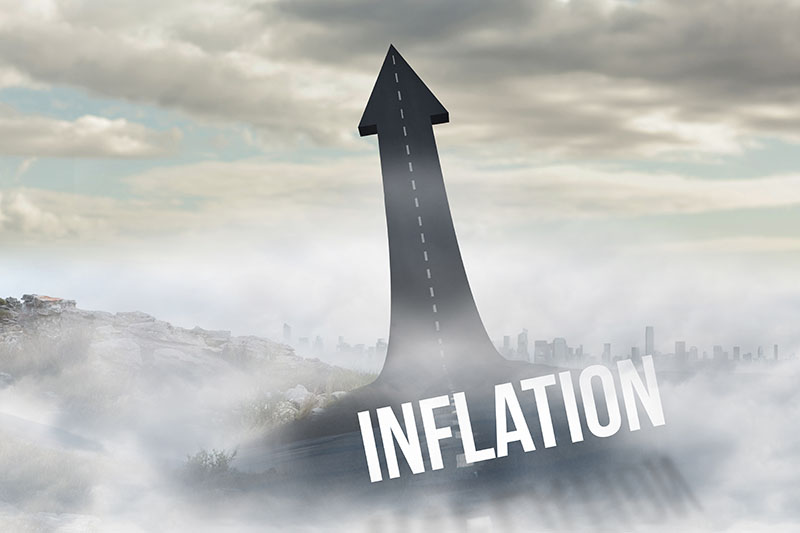(Justin Vaughn, Editor, Options Trading Report)
U.S. Inflation’s Relentless Rise Hits Fastest Pace In 39 Years!! U.S. inflation reached a nearly four-decade high in November as robust consumer demand out reached supply constraints. The Labor Department said the consumer-price index–which measures what consumers pay for goods and services–rose 6.8% in November from the same month a year ago. That was the fastest pace since 1982 and the sixth straight month in which inflation topped 5%. Most price increases were ‘across the board,’ however some categories such as autos, which came in at 11.1% in November, was the largest on record, as were those for men’s apparel and household furnishings. A 7.9% surge in fast-food restaurant prices last month marked the sharpest on record.also. Wages tracked by the Atlanta Fed climbed 4.3% in November, up from 4.1% in October and the highest since 2007. Some energy prices show signs of easing. The November prices trend came before the emergence of the Omicron Variant as it raised its ‘head.’ But the sharp price increases are the direct result of a ‘booming’ economy that developed from blaring imbalances in supply and demand during the recovery from the recovery. “We have tremendous spending by consumers. A lot of people are getting hired. Demand is huge,” said Allen Sinai, chief global economist and strategist at Decision Economics Inc. He added that higher-than-expected inflation implies a needed pullback in fiscal and monetary stimulus. “Even after doing that, the economy should still be in super shape producing growth rates and earnings not seen in decades.” A shortage of available workers is also affecting inflation and the overall economy, pushing companies to raise prices to offset higher labor costs. On Thursday Costco Wholesale Corp. said its prices likely grew between 4.5% to 5% in the most recent quarter, a bit higher than the company predicted. Persistently higher inflation is hitting consumer budgets….and it is likely to continue.
U.S. stocks finished the week higher after ‘fresh’ inflation data raised investors’ hopes that price increases may be nearing a peak. The S&P 500 closed at a record Friday, advancing about 1% or 44.57 points to 4712.02. The move marked the index’s largest one week percentage gain since the week ended Feb. 5th. The tech focused Nasdaq Composite Index was up 0.7% or 113.23 points to close at 15630.60. The Dow Jones Industrial Average was up 0.6% or 216.30 points to 35970.99. Noted investment economist, Edward Park of Brooks MacDonald, noted, “There’s a bit of relief in the market at the moment. It’s in line with the market expectations and in addition there’s an expectation this is the peak of year-on-year inflation numbers.
The Bourbon Boom Puts Kentucky Back On The Map…Bourbon’s growing popularity, undimmed by the pandemic has been a boon to Kenkucky, which from its earliest days has been associated with the production of “America’s native spirit.” Gin was America’s drink of choice in the early 20th century. In the mid-century the country went crazy for vodka. This is the golden age of bourbon whiskey. More than 28 million cases of American whiskey–that is bourbon and rye–were sold in the U.S. in 2020, yielding $4.3 billion in revenue for distillers. These days bourbon is a multibillion-dollar industry, but 100 years ago Kentucky’s bourbon producing small towns were on the cusp of a long and painful decline. The cause was…Prohibition. Just past midnight on Jan. 16, 1920, the 18th amendment went into effect, requiring the destruction of all distilleries and banning sale of all alcohol in the U.S. Overnight the ‘fortunes’ of thousands of rural ‘Kentuckians’ changed for the worse. Thousands of Kentuckians worked in distilleries and adjacent industries such as bottling and distribution. “All the rural plants were closed down, and most were dismantled and equipment salvaged,” whiskey historian Sam K. Cecil writes in “The Evolution of the Bourbon Whiskey in Kentucky.” “Some buildings were converted to other uses or left to deteriorate if they had no further value for re-use.” Prohibition was repealed on Dec. 5, 1933, but few distilleries reopened. Many of the rural Kentucky distilleries that survived Prohibition were acquired by larger brands and foreign liquor conglomerates. Most eventually moved to Louisville. Now a century later, Bourbon production, with many ‘big’ corporations involved, has increased more than 360% since 2020 and the industry is now valued at a whopping $8.6 billion. It’s also gone global with Kentucky exporting over $570 million in 2019. Bourbon is Back, with a Glowing Future.
RUMBLINGS ON THE STREET
Aneta Markowska, chief economist at Jefferies, Barron’s “The big gap in hiring, taken at face value, suggests that over one million individuals shifted from employment to self- employment. The household survey (The Labor Department conducts two surveys each month that together constitute its employment situation report) has historically been more volatile and thus less reliable if people are shifting to self employment, as anecdotal evidence suggests, the household survey may be painting a more accurate picture of the labor market,” Markowska says.
Stephen Kim, a housing analyst at Evercore, Barron’s “The supply shortage built up over 10 years, and it won’t go away quickly.”
Rick Rieder, Blackstone’s chief investment officer of global fixed income, Barron’s Mr. Rieder sees current high inflation melting away by the end of 2022. “Both overall and “core” inflation (excluding food and energy costs) are likely to be down in the 2.5% to 3% range by then, as supply-chain constraints ease,” as he writes in a media note. He sees wage gains remaining strong, a reversal of the past 121 months.
Oxford’s Sarah Gilbert, who developed the Oxford-AstraZeneca Covid vaccine, Barron’s “This will not be the last time a virus threatens our lives and our livelihoods.”

